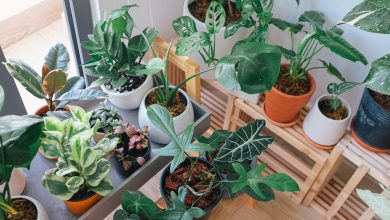How to Automate Your Garden with Smart Garden Devices

Maybe you’re an experienced gardener, or maybe you’re looking at getting into the bobby despite lacking time to pursue it seriously. No matter the case, in today’s day and age, there are a number of easy technological solutions to digitalize and almost automate your garden.
We will cover a wealth of different smart garden devices that can help you take care of your projects without having you take a single step outside. Some of these might be able to track air and soil temperatures, moisture levels, humidity, and PH levels, while others will automatically maintain your garden when you just don’t have the time.
In today’s post, we’re going to start by taking a look at the top technological gardening innovations of 2020 and talk about how to efficiently use these newfound gadgets to create a stunning garden in the busier moments of our lives.
Outdoor Smart Gardening Devices

Weather Stations
If you’re taking care of an outdoor garden, you’re probably checking the weather forecast frequently to stay on top of how it might affect your plot. After all, it might derail any plans you’ve got for the maintenance required to keep your plants alive and healthy.
Monitoring the weather these days can be as simple as buying a weather station. Although these products seem like they might be for more of an advanced hobbyist, the newer wifi-enabled weather stations closely keep track of some incredibly important information. By keeping an eye on the temperature, rainfall levels, and wind, you can be more prepared than your average gardener for just about any weather conditions headed your way.
First thing in the morning, it may be incredibly clear outside, and you’re looking at a day of sunshine while you’re out at work, but there is still a slight chance of rain. When you keep track of how much it rained, you’re given a clear indication of whether or not you’ll need to water your plants. And for the sake of efficiency, you’ll even save money on your water bill if you can avoid turning on your garden hose just to give your plants an extra sip of water.
Using a weather station can also help you decide on when to plant. Some weather stations are able to track soil temperatures, enabling you to make sure your seeds start growing in a hospitable environment at the most opportune moment. Using a wifi-enabled variant, you can set an alert to be sent to either your phone or an email that will let you know the exact moment the temperature conditions are ideal for your seeds or seedlings. And it’s even useful in the winter months! During a cold winter, your soil might get a little bit frosty, and this device can also tell you when it’s time to bundle up your plants to keep them well protected from the winter chill.
A strong gust of wind could also be incredibly damaging to your hanging plants or even topple some of your smaller trees. Now, you likely have a contingency plan in place for those windy days, but on the odd day that you’re stuck at work and can’t make it to your plants, having an alert for strong winds could be a lifesaver. It’s as easy as giving a friend or family member a quick phone call so that they can take your hanging baskets down or put up support structures up for your trees.
Having a weather station might be just the right solution to help you plan around the weather conditions that could put your gardening projects on hold.
Automatic Watering Systems
As an efficient gardener, you’ve likely set up a drip irrigation system or an automatic watering system that runs on a timer. But using a wifi-enabled watering system paired with a device that measures the moisture in your soil is proving to be the smartest modern approach to keeping your garden watered.
Whether or not your weather system or soil monitor has let you know that it’s time for your garden to have a drink, there’s no longer a need to go out to your garden with a watering pail. Imagine sitting down in your backyard on a hot sunny day, and all you want to do is relax – getting up to water your garden can be time-consuming, and it totally takes away from the rest you’d be getting. However, this nifty high-tech approach allows you to simply open an application on your phone or computer to get the job done. You can also set custom timers according to the weather or even shut your watering system off without having to step into the rain.
As far as smart automatic watering systems go, there are some fairly basic ones that you can get started with at your local hardware store. But if you are technologically inclined – you can dive right into the realm of homemade alternatives. These DIY versions make use of Arduino or Raspberry Pi boards to further enhance and customize the feature kit of your device.
All in all, smart automatic watering systems can take a load off of your shoulders, allowing you to sit back and enjoy the beauty of your garden without having to get up and water it yourself.

Light Sensors And Lighting Systems
Are your plants getting enough light? When browsing for a new addition to your smart garden, it might be important to keep track of how much light your plants are actually getting. There are several products you can use to achieve better lighting, ranging from weather stations, to plant monitors, or even individual light sensors.
Using a light sensor can be a great way to expand the capability of your garden. Some days you might find yourself thinking that you’d like to grow a certain kind of plant or vegetable, only to realize that it just isn’t doable because there just wouldn’t be enough light. To compensate for any luminary shortcomings, you can pair a light sensor with an automatic lighting system and some outdoor full-spectrum LED grow lights. And since most sensors come with Wi-Fi or are Bluetooth enabled devices, you can easily control the amount of light that your plants receive at any given moment.
Plant Monitoring Systems
Not every gardening project involves working with an entire garden. At times you might just be focused on raising one particular plant or tree. Above, we took a look at a few devices that monitor things like the amount of light or water that your plants receive. But in the event that you’re working with a single plant, there’s a device that monitors everything you’d want to know to take care of your plant.
A plant monitor is either a Bluetooth or Wi-Fi enabled device that logs information such as the soil moisture, soil fertility, light, and temperature all in one. The apps that pair with these devices are incredibly user-friendly. It will immediately indicate in red lettering what might need to be taken care of as soon as it needs to happen.
These devices are a sort of probe. To measure soil moisture, they often have two or more legs that will measure the capacitance between each other. It is incredibly important to make sure that your probe is firmly placed in the soil for an accurate reading. Similar to measuring the soil moisture, the probes also estimate soil fertility by measuring the conductance between different points on the probe. This allows it to detect ionic soil nutrients, including potassium, nitrogen, and phosphorus, or potentially give you an indication of other important nutrients like calcium, boron, magnesium, or sulfur.
While it’s quite an impressive feature, not every device is guaranteed to be able to give you a pin-point accurate report on the mineral content of your soil. It would be best to use this feature as more of a guideline. Additional soil testing is still the most accurate and efficient way to take care of your soil and any large plants you’ve got growing in it.

Robotic Lawnmowers
Similar to automatic vacuum cleaners (like Roombas) picking up dust and dirt around your home, you can get an automatic lawn mower to keep the grass in your backyard tamed and well-maintained. The name “Robotic Lawnmower” might lead you to think that they come out of some variety of sci-fi novels. However, these things are an absolute lifesaver, especially if you have a larger plot of land.
There’s nothing more frustrating than taking a good look at your lawn and seeing tall patches of uneven grass all over. To get started with a robotic lawnmower, you have to set boundary wires around the perimeter of your yard and the edges of any garden space that sits flush with the grass. After setting up your perimeter wire, install the dock that the lawnmower would operate from, and get ready to program it.
Using your favorite device or the small control panel on the front of your lawnmower, you can have it programmed and calibrated in just a matter of minutes. After a few laps around the perimeter, it should map out and become familiar with your backyard. The internal memory-maps it stores allow it to function without running into any obstacles. You can also set it to run on a timer to ensure that your grass consistently stays at the same height over time.
While you might think that your lawn might not be a part of your garden, it’s certainly pleasing when everything looks in order. After all, a beautiful, well-trimmed lawn only accentuates the beautiful garden space that you’ve worked so hard to achieve.
Sonic Pollinators
So far, we’ve discussed automating your gardening experience. But we haven’t quite taken a look into any of the new manual technology available. A beginner gardener likely isn’t going to think of manually cross-pollinating their own plants. But an adept gardener knows that cross-pollinating, when done correctly, will produce stronger and healthier plants in the long run.
In the past, one would typically use a small brush or a cotton swab to swap pollen between plants. Instead of the old fashioned, invasive methods of collecting pollen, you can now use what’s called a “Sonic Pollinator.” Sonic pollinators are designed to mimic the same sound, vibration, and frequency of a busy bee’s beating wings. Plants naturally sense pollinating insects and release some of their pollen so they can, in exchange, receive pollen themselves.
Pollinators typically come with a small spoon or another utensil for you to collect pollen with. You just have to place your sonic pollinator on the back of the flower of a plant with the spoon directly below the flower. Afterward, you can gently move other flowers towards the spoon and rub the pollen directly into the flower. That’s it! An easy-peasy noninvasive way to cross-pollinate your plants.
With a rapidly dwindling global bee population, a sonic pollinator could be a fantastic way to make sure that your garden gets pollinated properly.
Indoor Smart Gardening
Gardening should be for everyone! However, unfortunately, a lot of people feel that not having an outdoor space bars off this fun and engaging hobby, especially in urban areas. In the past, getting into indoor gardening was a tough quest to undertake. Grow lights were more expensive and would eat up your electric bill, not to mention regulating temperature isn’t always easy. And an indoor garden could get quite messy as well.
Thankfully, in modern times, there happen to be a few smart ways to create the indoor garden that you’ve always wanted, without the hassle!
To help you plan your indoor garden, we’ll take a look at automated garden boxes and cabinets, wall gardens, and indoor hydroponic kits to get you started.

Growing Boxes And Cabinets
Finding space for an indoor garden can be difficult. Previously, you’d likely have to buy or build your own garden boxes and rig a few grow lights to them as a base-line setup. Grow boxes and grow cabinets are a small and compact, eco-friendly way of growing plants and vegetables in the comfort of your own home.
One of the key differences between indoor and outdoor gardening is the wealth of different variables that you have to pay attention to. You’re always checking on your soil nutrients, moisture, and pH, or the amount of light that your growing veggies are getting. The new innovative smart growing boxes and cabinets allow you to be in complete control of your indoor gardening experience at all times. And if you don’t want to deal with the mess of having a soil garden in your home, there are even hydroponic alternatives to meet your needs.
Thanks to the energy efficiency of LED lights, you’re also able to get a full spectrum experience with your smart garden without heavily biting into your electric bill. Most of these grow kits seem to use less energy than a refrigerator and just a tiny bit more than a ceiling fan. And as we progress into the technology-laden future, we’re sure to see more advanced kits that may even be able to change the wavelength and spectrum of their equipped LED lights. This could be incredibly useful if you’d like to have full control of the type of light your plant receives. And in addition to low energy consumption, most smart boxes come equipped with a set and forget watering feature, leaving you with very little work to be done.
They also generally come equipped with Wi-Fi and Bluetooth, which allows you to monitor the conditions in your gardens and even supply nutrients and water to your plants while you’re at work or on the go.
These indoor kits are more affordable than ever and are rapidly becoming increasingly more convenient as the years go by. Smart growing boxes are highly recommended as a foolproof way to grow your favorite flowers, herbs, and vegetables in the comfort of your own home.
Indoor Grow Walls
Every home has a wall that could use a little bit of decoration. And there’s no better way to decorate a wall than to spruce it up with a garden shelf or mounted garden box.
You can either build your own indoor vertical grow wall and automate it yourself, or you can simply buy something prepackaged online. Grow walls are quite similar to the indoor boxes and cabinets that we just covered. However, they have a few key differences. Some are better for hobbyists and require a bit of work to get started, while others are designed to take all the hassle out of your gardening experience and offer out-of-the-box automation.
The most common grow walls are open style hydroponic kits. Each shelf is equipped with a tube full of water and a grow light behind each layer. The open design shelves are great for growing herbs or your favorite leafy greens, allowing you to harvest them at your leisure. Hydroponics is also one of the cleanest gardening methods because you don’t have to deal with the mess that a soil garden would typically bring with it.
However, open style grow walls aren’t the only available option. Closed kits often resemble growing boxes and cabinets and use a soil system rather than hydroponics. The main difference is in the fact that they are wall-mounted. And of course, they come fully automated with built-in watering systems, grow lights, and soil health sensors.
The shelf style grow wall is a bit more common when it comes to picking one up at your local gardening supply store. But there are also a handful of other (less-smart) products that mount to your wall. These will allow you to grow your plants anywhere in your house. They make a great alternative for people who don’t quite have the necessary space for a fully automated kit. The installation and setup for the wall-mounted systems can often take as little as ten minutes and generally requires little to no effort and know-how to get started with.

Smart gardening is an incredible way to enhance your gardening experience. In the past, monitoring your plants and maintaining your garden may have proved to be a daunting task.
But in modern times, innovative solutions like outdoor weather sensors take the guesswork out of gardening efforts. These solutions take care of the crucial little details from weather forecasting and plant monitoring, to automatic watering, and even giving your plants the right amount of light. Thanks to advances in energy-efficient technology and the ingenuity of those who design smart gardening products, you can easily grow your favorite plants year-round, whether indoors or outside. Thanks to all of this technology, gardening has never been easier – and it will definitely be exciting to see what we’ve got in store for the near future!



